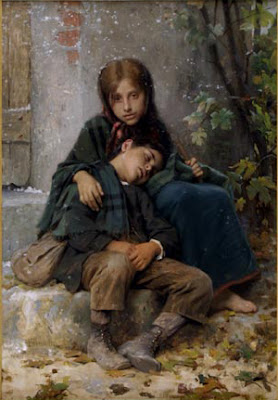 |
| The Young Schoolmistress, 1740, Jean-Baptiste Siméon Chardin. Chardin painted children concentrating. That is only possible when children aren’t worrying. |
I spent two decades in a town where, as Garrison Keillor quipped, “all the children are above average.” It’s fringed by the University of Rochester and Rochester Institute of Technology, and provides those professors a green, leafy suburb in which to hang their hats.
Jennifer and I taught Sunday school together years ago. She’s got a PhD and is a professor of optics. Another friend once lamented that with “only” an MA in Spanish literature, she was the least-educated person she knew. (Since my education was largely cobbled together, I found this funny.)
As you can imagine, the children of such parents never go to bed intellectually starved.
Jennifer met Helen, a former gang-banger from Braddock, PA, several years ago. She coached her in writing skills, among other things. Helen is a Resident Advisor for the mentally ill in an enclosed program. She suffers from sarcoidosis, recently came through a bout of homelessness and is the legal custodian of her two-year-old granddaughter. She is mixed-race and 52 years old.
 |
| Young Beggars, 1890, by William-Adolphe Bouguereau. They have more to worry about than their book learning. |
Helen and I have become good friends. Recently, Helen decided to quit swearing. She was putting quarters into a swear-jar when I realized she couldn’t divide by four. We started to probe the limits of her education.
She has read no classic literature or poetry. She does not know basic computation. She writes easily and breezily, but her vocabulary is on an elementary-school level. All of this might be understandable if Helen were a recent immigrant from the third world, but she’s a middle-aged graduate of an American high school.
Helen was born in 1964 to an interracial couple. Her physically-disabled mother was four months pregnant when her parents were married. Her father was a drug-dealer who did time. Helen was told in school that she was learning-disabled. I see no evidence to support that. To me, it seems more likely that she was unable to concentrate.
 |
|
Buffalo Newsboy, 1853, by Thomas Le Clear, courtesy Albright-Knox Art Gallery. Expectations for the working poor were very different in the 19th century.
|
Right now, Helen is working on learning her times tables, and is reading the speeches of Malcolm X, the Book of Acts and Dickens’ Great Expectations. I assign her four vocabulary words every day, emphasizing what part of speech they are. We’ve discussed remainders, thesis statements, and how to outline.
“Aleara is learning her multiplication tables. My six-year-old granddaughter and I are learning at the same time,” she marveled.
One of the subjects we’re talking about is budgeting. That’s not trivial; that’s how the middle classes get ahead. But you can’t budget if you can’t do basic computations.
 |
|
Pauvre Fauvette, 1881, by Jules Bastien-Lepage. The 19th century French poor were less socially-mobile than our own poor of the time. This little warbler was stuck where she was born
|
Next door to my old community is the Rochester City School District. It earned a public hiding a few years ago, for turning in the lowest black male graduation rate in the nation: 9%. At the same time, it had one of the highest costs-per-student in the country: $20,333 per kid in 2013. But if you think I’m going to criticize the teachers, you’re wrong. I know many city school teachers. To a man or woman, they’re dedicated, serious, and optimistic.
We can argue about politics, money, motivation, broken households, family support, etc. but it would help by starting with an admission that something is seriously broken. For forty years, Helen believed the lie that this is the best she was capable of doing. We owe her grandchildren a better start than this.
